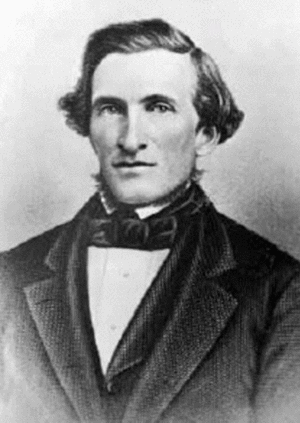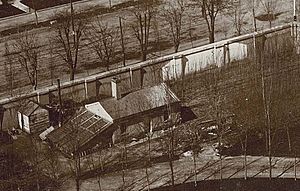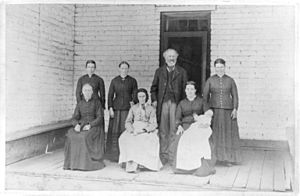Mormon Reformation facts for kids
The Mormon Reformation was a time when members of The Church of Jesus Christ of Latter-day Saints (LDS Church) focused on becoming more spiritual. It was a movement led by church president Brigham Young between 1856 and 1857. During this time, Young sent his helper, Jedediah M. Grant, and other church leaders to teach people across Utah Territory and other Latter-day Saint communities. Their goal was to inspire people to stop doing wrong things and focus on spiritual matters. As part of this movement, almost all active church members were rebaptized. This was a symbol of their renewed commitment. The Reformation had three main parts: changing church structure, asking for clear signs of spiritual change, and finally, focusing on love and rebuilding.
Contents
History of the Mormon Reformation
Early Challenges in Utah
When pioneers came to Utah Territory between 1847 and the mid-1850s, they were welcomed. This included both members of the LDS Church and others who supported them. Everyone was asked to help build up Zion, which meant a lot of hard physical work. People who helped build the settlements were very important. At first, small issues like smoking or not going to church did not usually cause problems for them. By the early 1850s, many communities were doing well. However, some people were not following all the strict rules of the LDS Church.
In 1852, Brigham Young announced the practice of plural marriage to the world. Soon after, the Latter-day Saints in Utah faced difficult times. Many new converts from Europe and America had moved to the territory. In 1855, a serious drought hit the area because there was little snow the winter before. On top of the drought, grasshoppers and crickets ate many of their crops. About one-third of the cattle also died from the cold. During the winter of 1855–56, basic foods like flour became very hard to find and very expensive. Heber C. Kimball wrote that money did not mean much then because times were so tough.
Church Leaders Get Involved
In September 1856, as the drought continued, people started to deeply examine their lives. Church leaders believed the hard times were a sign from God. They felt something was needed to help the Saints survive and grow spiritually. Brigham Young said at a meeting on September 21, 1856: “We need a reformation... a thorough reform.”
Jedediah M. Grant, a helper in the First Presidency, became a strong voice for the movement. He was known for being smart, generous, and a powerful speaker. These qualities helped the Reformation. In Kaysville, Utah, Grant and Joseph Young of the First Council of the Seventy gave sermons for four days. They asked people to repent and promise to live better lives. Five hundred people were rebaptized to show their commitment.
This strong message spread from Kaysville to other Mormon communities. Church leaders traveled around the territory. They talked about their worries that people were losing their spiritual focus. They asked everyone to repent. Members were asked to be rebaptized as a sign of their new dedication. A new baptism font was built on the east side of the Endowment House on Temple Square just for these rebaptisms. Rebaptism was not new; it had been done since the 1830s. However, the First Presidency later stopped encouraging it in 1879.
The meetings led by Grant and Young were similar to earlier religious gatherings in the 1830s. People experienced things like speaking in tongues, prophesying, and seeing visions. These experiences had not been common in Nauvoo or earlier in Utah.
Spreading the Message
All three members of the First Presidency and several apostles supported the Reformation. They gave powerful sermons, encouraging people to follow church teachings more strictly. They also urged rebaptism to prepare for the full practice of "celestial law" in Utah. They believed the Second Coming of Jesus would happen soon. Brigham Young was very important in spreading the Mormon Reformation. He emphasized plural marriage, rebaptism, and gave passionate speeches. He also spoke about some ideas that other church leaders did not accept, such as blood atonement and the Adam-God doctrine. Brigham Young said: "The time is coming when justice will be laid to the line... when we shall take the old broadsword and ask, Are you for God?"
By the end of September 1856, the Reformation had grown strong. It spread to all Mormon settlements. Throughout the winter, special meetings were held. Church members encouraged each other to follow God's commandments and church practices. Preaching focused on plural marriage, following the Word of Wisdom, attending church meetings, and personal prayer. Sermons also talked about being clean and dressing well. Jedediah Grant urged members to keep their baptism promises by "observing cleanliness in their persons and dwellings."
Even though Grant died of pneumonia in December 1856, the Reformation continued to spread. On December 30, 1856, all members of the Utah territorial legislature, who were Mormons, were rebaptized. They were also reconfirmed by the Twelve Apostles.
During this time, some groups may have tried to make sure people followed the rules. There were rumors that some committees made quick decisions about local troublemakers. People sometimes called these enforcers "Danites" or "destroying angels." For example, John Chatterley, a pioneer, wrote that he received threats from a "secret Committee, called... 'destroying angels'" in late 1856 and early 1857. Some people at the time pointed to speeches by Brigham Young and Jedediah Grant that seemed to support such actions. However, Young denied that he or church leaders approved of such acts. In 1867, Young said: "Is there war in our religion? No; neither war nor bloodshed... Such is all nonsense and folly in the extreme."
The Reformation also affected the culture in Utah. The Polysophical Society, started in 1854 by Lorenzo Snow and his sister, Eliza R. Snow, promoted public education. It offered lectures, music, and poetry.
Historian Dean L. May noted that not everyone in Utah accepted the most intense parts of the Reformation. Like other religious movements, the great excitement and dramatic changes could not last forever. By spring 1857, with the return of normal rains, religious life went back to its usual ways. The Reformation seemed to end completely by early 1858.
Blood Atonement
Some earlier sermons by Willard Richards and George A. Smith mentioned the idea of blood atonement. This idea suggested that people who left the church (apostates) or committed very serious sins, like murder, could not be saved by Jesus Christ's sacrifice. Instead, they could only be saved by willingly shedding their own blood.
The LDS Church officially stated that blood atonement is not church doctrine. This was done in a statement published in the Deseret Weekly in 1889. It was also confirmed by a letter from apostle Bruce R. McConkie in 1978, speaking for the First Presidency.
Impact of the Reformation
The Mormon Reformation had lasting effects on church members, their families, and the church itself. Some main results were: people renewed their personal commitment, communities found new ways to work together, church members felt more united, and more people entered plural marriages. Gustive O. Larson wrote that "Mormonism was a civilizing force" in the Great Basin. He said the call to repent was generally followed. As a result, historian Andrew Neff said, "the spiritual tone of the entire Mormon commonwealth was markedly raised."
According to historian Paul H. Peterson, promises to follow church practices led to a clear increase in plural marriages. Many men who had not taken plural wives before were sealed to one or more. Research by Stanley S. Ivins shows that the number of plural marriages was 65 percent higher in 1856–57 than in any other two-year period in Utah.
The Reformation also made church members feel more united and practical. Historians James Allen and Glen Leonard pointed out that the Reformation "may have accounted for the fact that the following year the Saints were emotionally prepared to confront the army of the United States en route to Utah." During this conflict, known as the Utah War, Mormon militia were ready to act on the plains and in Wyoming. Also, church members were prepared to leave and destroy their homes, farms, and businesses. They were ready to move again to the White Mountains of Arizona, which Young had chosen as a possible safe place if a full war started. Some historians also believe that the strong words from church leaders contributed to the defensive actions in Southern Utah. These actions eventually led to the Mountain Meadows massacre.
Additionally, church leaders started a program to assign two "home" or ward missionaries to each local church group. A similar program still exists today, called ministering. These missionaries visited each family in their ward. They checked on their needs and offered help. They also asked about family members' spiritual commitment. After some months of these visits, Latter-day Saints in Salt Lake City and nearby communities who had not been rebaptized were asked to do so. This showed their ongoing commitment to the church. Paul H. Peterson says that those who refused to be rebaptized might "lose their membership in the church." In Britain, many less committed members were removed from church records. A small number of less active church members left Utah, returning east or going to California.
Images for kids







